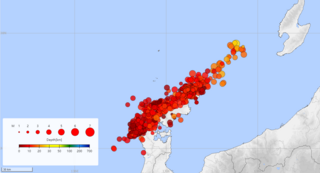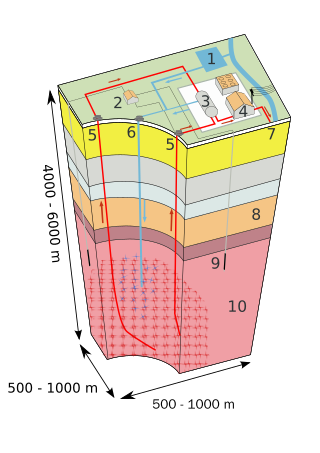
An earthquake – also called a quake, tremor, or temblor – is the shaking of the Earth's surface resulting from a sudden release of energy in the lithosphere that creates seismic waves. Earthquakes can range in intensity, from those so weak they cannot be felt, to those violent enough to propel objects and people into the air, damage critical infrastructure, and wreak destruction across entire cities. The seismic activity of an area is the frequency, type, and size of earthquakes experienced over a particular time. The seismicity at a particular location in the Earth is the average rate of seismic energy release per unit volume.

Geothermal energy is thermal energy extracted from the Earth's crust. It combines energy from the formation of the planet and from radioactive decay. Geothermal energy has been exploited as a source of heat and/or electric power for millennia.

In seismology, an earthquake swarm is a sequence of seismic events occurring in a local area within a relatively short period. The time span used to define a swarm varies, but may be days, months, or years. Such an energy release is different from the situation when a major earthquake is followed by a series of aftershocks: in earthquake swarms, no single earthquake in the sequence is obviously the main shock. In particular, a cluster of aftershocks occurring after a mainshock is not a swarm.
Induced seismicity is typically earthquakes and tremors that are caused by human activity that alters the stresses and strains on Earth's crust. Most induced seismicity is of a low magnitude. A few sites regularly have larger quakes, such as The Geysers geothermal plant in California which averaged two M4 events and 15 M3 events every year from 2004 to 2009. The Human-Induced Earthquake Database (HiQuake) documents all reported cases of induced seismicity proposed on scientific grounds and is the most complete compilation of its kind.
An earthquake light also known as earthquake lightning or earthquake flash is a luminous optical phenomenon that appears in the sky at or near areas of tectonic stress, seismic activity, or volcanic eruptions. There is no broad consensus as to the causes of the phenomenon involved. The phenomenon differs from disruptions to electrical grids – such as arcing power lines – which can produce bright flashes as a result of ground shaking or hazardous weather conditions.

The Geysers is the world's largest geothermal field, containing a complex of 18 geothermal power plants, drawing steam from more than 350 wells, located in the Mayacamas Mountains approximately 72 miles (116 km) north of San Francisco, California.

An enhanced geothermal system (EGS) generates geothermal electricity without natural convective hydrothermal resources. Traditionally, geothermal power systems operated only where naturally occurring heat, water, and rock permeability are sufficient to allow energy extraction. However, most geothermal energy within reach of conventional techniques is in dry and impermeable rock. EGS technologies expand the availability of geothermal resources through stimulation methods, such as 'hydraulic stimulation'.

Geothermal power is electrical power generated from geothermal energy. Technologies in use include dry steam power stations, flash steam power stations and binary cycle power stations. Geothermal electricity generation is currently used in 26 countries, while geothermal heating is in use in 70 countries.
An injection well is a device that places fluid deep underground into porous rock formations, such as sandstone or limestone, or into or below the shallow soil layer. The fluid may be water, wastewater, brine, or water mixed with industrial chemical waste.

The Swiss Seismological Service at ETH Zurich is the federal agency responsible for monitoring earthquakes in Switzerland and its neighboring countries and for assessing Switzerland's seismic hazard. When an earthquake happens, the SED informs the public, authorities, and the media about the earthquake's location, magnitude, and possible consequences. The activities of the SED are integrated in the federal action plan for earthquake precaution.

The Hellisheiði Power Station is the eighth-largest geothermal power station in the world and largest in Iceland. The facility is located in Hengill, southwest Iceland, 11 km (7 mi) from the Nesjavellir Geothermal Power Station. The plant has a capacity of 303 MW of electricity and 200 MWth of hot water for Reykjavík's district heating. The power station is owned and operated by ON Power, a subsidiary of Reykjavík Energy.

The Fessenheim Nuclear Power Plant is located in the Fessenheim commune in the Haut-Rhin department in Grand Est in north-eastern France, 15 km (9.3 mi) north east of the Mulhouse urban area, within 1.5 km (0.93 mi) of the border with Germany, and approximately 40 km (25 mi) from Switzerland. Unit 1 was closed in February 2020 and unit 2 on 29 June 2020.
A potent magnitude 6.6 Mw intraplate aftershock occurred at 17:16 JST (08:16 UTC) on 11 April, in the Hamadōri region of Fukushima, Japan. With a shallow focus of 13 km (8.1 mi), the earthquake was centred inland about 36 km (22 mi) west of Iwaki, causing widespread strong to locally severe shaking. It was one of many aftershocks to follow the 11 March Tōhoku earthquake, and the strongest to have its epicentre located inland.
The 2011 Kütahya earthquake struck near a populous region of western Turkey at 23:15 EEST (20:15 UTC) on 19 May with a moment magnitude of 5.8 and a maximum Mercalli intensity of VII. With an epicenter just to the east of Simav, it occurred at an estimated depth of 9.1 kilometers (5.7 mi), resulting in strong shaking in much of Kütahya.

The Oklahoma earthquake swarms are an ongoing series of human activity-induced earthquakes affecting central Oklahoma, southern Kansas, northern Texas since 2009. Beginning in 2009, the frequency of earthquakes in the U.S. state of Oklahoma rapidly increased from an average of fewer than two 3.0+ magnitude earthquakes per year since 1978 to hundreds each year in the 2014–17 period. Thousands of earthquakes have occurred in Oklahoma and surrounding areas in southern Kansas and North Texas since 2009. Scientific studies attribute the rise in earthquakes to the disposal of wastewater produced during oil extraction that has been injected more deeply into the ground.

The 2017 Pohang earthquake, measuring magnitude 5.4 on the Richter magnitude scale, struck Heunghae, Pohang, North Gyeongsang Province, South Korea on November 15, 2017. It is tied with the 2016 Gyeongju earthquake as the country's strongest earthquake in modern history, and the most destructive ever recorded with "an estimated 300 billion won in damage."












